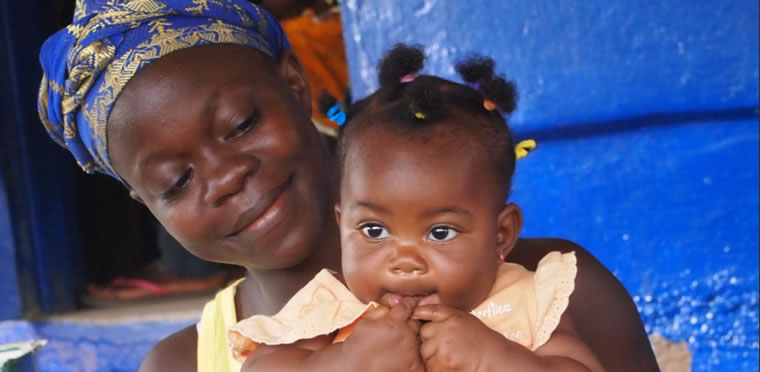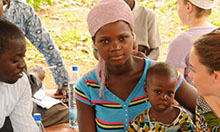
Global Nutrition Efforts
Around the world, some two billion people live on a diet lacking the nutrients needed to live healthy and productive lives, and more than 200 million children under the age of five suffer from chronic undernutrition as manifest by stunting, wasting,1 and severe wasting. When that undernutrition affects the 1,000-day window from conception to a child’s second birthday, one of many consequences is mental impairment that affects the child’s entire life cycle. Children affected by stunting are more susceptible to sickness, fare poorly in school, enter adulthood more prone to noncommunicable diseases, and at work often earn less than non-stunted coworkers. When undernutrition affects girls and follows them into adolescence, the cycle begins all over again.
The world community is reacting with increasing urgency to the gravity of this situation and its effects for the long term, focusing on global undernutrition, especially among pregnant women and children under two years of age, and aligning and increasing resources and building partnerships to alleviate suffering caused by undernutrition. Since 2010, more than 100 government, civil society, and university groups have endorsed the framework and roadmap for the Scaling Up Nutrition (SUN) Movement, which are grounded in nutrition actions endorsed by The Lancet in its landmark series Maternal and Child Undernutrition, published in 2008 with an update in 2013—nutrition actions proven to combat malnutrition during these critical first 1,000 days.2 The 1,000 Days initiative, a global effort to implement the SUN framework and roadmap at country level, was endorsed in 2010 by more than half a dozen ministers and heads of organizations after its launch at an event hosted by United States Secretary of State Hillary Clinton and Irish Foreign Minister Micheál Martin.
Peace Corps
Peace Corps has identified nutrition as a key focus area of its interventions under Feed the Future, the United States government’s global hunger and food security initiative. To further the goals of Feed the Future, in 2011, Peace Corps and USAID signed the Global Food Security Agreement and USAID/West Africa Regional Mission, and the Peace Corps established the USAID/Peace Corps West Africa Food Security Partnership (WAFSP). Support from USAID/West Africa facilitates opportunities for synergistic food security programming between three West African Feed the Future focus countries (Ghana, Liberia, and Senegal) and seven West African countries that, although not participating in Feed the Future, are targeted by Peace Corps programs (Benin, Burkina Faso, Cameroon, Gambia, Guinea, Sierra Leone, and Togo). The funding is supporting small grant projects, trainings, technical exchanges, and materials development.
Globally, Peace Corps has also encouraged its country programs to adopt and adapt tested and proven field tools such as the trio of publications designed for training in and communication about essential nutrition actions (ENA), key nutrition interventions, supported by USAID, aiming to achieve broad public health impact.
Peace Corps believes that greater progress and impact will result from harmonizing the field approaches and tools of many different groups. Harmonization is critical: Resources are scarce, and the task ahead is immense. At the country level, the need for harmonization will mandate that many different field groups work in synchrony and with intention to build program synergies, to combine efforts whenever possible, and to leverage all available resources for a single purpose.
The training’s goal is to empower Peace Corps Volunteers (PCVs) and Community Volunteers (CVs) with knowledge and proven-effective messages on women’s nutrition, infant and young child feeding (IYCF) practices, the importance of micronutrients and hygiene practices, and the basics of homestead food production (HFP).
The training introduces the concept of behavior change communication (BCC) and explores how different community channels and platforms can be adapted to PCV activities around ENA as well as Essential Hygiene Actions (EHA) and (HFP). In addition, the training builds crucial negotiation and interpersonal communication skills to enable PCVs and CVs to optimally integrate high-impact nutrition interventions into their daily activities.
For More Information on 1,000 Days, please visit http://www.thousanddays.org/
Informed by the knowledge and supported by the skills from this training, PCVs and CVs have an exciting opportunity to contribute their own support to significant global initiatives aimed at combating malnutrition during the critical first 1,000 days.
About the Essential Nutrition Actions
In 1997, the USAID-funded Basic Support for Institutionalizing Child Survival (BASICS) project introduced a new approach to nutrition and health, the Minimum Package for Nutrition. Subsequently, this “MinPak” was renamed Essential Nutrition Actions (ENA).
The ENA framework represents a comprehensive strategy for reaching 90 percent coverage with high-impact nutrition interventions in order to achieve public health impact. Designed to manage the advocacy, planning, and delivery of an integrated package of preventive high impact nutrition actions, this operational framework has been implemented across Africa and Asia; ENA implementation is carried out by health facilities and community groups. At multiple contact points, health services support women and young children during their first 1,000 days—from conception through age two—a period when nutrient requirements are increased, the risks of undernutrition are great, and the consequences of deficiencies are most likely to be irreversible over the child’s life course. All of the essential nutrition actions have been proven to improve nutritional status and reduce mortality.3
Essential Nutrition Actions
- Nutrition for adolescents and women during pregnancy and lactation
- Exclusive breastfeeding during the first six months of life
- Complementary feeding starting at six months, with continued breastfeeding to two years of age and beyond
- Nutritional care of sick or malnourished children
- Prevention of vitamin A deficiency in women and children
- Prevention and control of anemia in women and children
- Consumption of iodized salt household members.
The ENA framework promotes and supports “nutrition through the life cycle,” addressing women’s nutrition during adolescence, pregnancy and lactation, optimal infant and young child feeding (i.e., breastfeeding and complementary feeding), nutritional care of sick and malnourished children (e.g., with zinc, vitamin A, and ready-to-use therapeutic foods (RUTF)), and the control of anemia, vitamin A, and iodine deficiencies. The ENA framework requires integration of key messages and services into all existing health sector programs.4 In particular, integration means reaching mothers and their babies and children at critical contact points, such as in maternal health and prenatal care, in delivery and neonatal care, in postpartum care for mothers and infants, during family planning, at immunizations, at well-child visits (which include growth monitoring, promotion, and counseling), at sick-child visits (including integrated management of newborn and childhood illnesses and integrated community case management), and during outpatient therapeutic care as part of community-based management of acute malnutrition.
The appropriate messages and services are also integrated to the greatest extent possible into programs outside the health sector, such as at agriculture and food security contacts (e.g. homestead food production and agriculture extension agents), in education (e.g., pre-service and in primary and secondary schools) and literacy education, and as part of microcredit and livelihoods enhancement. Implementing the ENA framework entails building partnerships with all groups supporting maternal and child health and nutrition programs, so that messages are harmonized and all groups promote the same messages using the same job aids and information and education communication materials. Ideally, partners are brought together at regional and national levels to agree on the harmonized approaches and to advocate with policy leaders for the importance of nutrition to the nation’s economic as well as social development.
Messages are crafted to highlight actions that are small and doable, and techniques of social and behavior change communications are used to promote adoption of these actions. Special emphasis is given to interpersonal communications—notably, during counseling of individual mothers or during group events—that are reinforced by mass media and at community festivals and other mobilizing events. Health and community agents are trained to employ negotiations for behavior change—visiting mothers in their households or at markets, at their chores, at women’s group meetings, and at community meeting places—and helping them anticipate and overcome barriers to carrying out new practices.
Existing ENA training materials can strengthen those individuals’ ability to promote ENA by negotiating for behavior change. Although content remains generally fixed from one country or region to the next, formative research can shape the details of adaption to the context.
1 Andrew Thompson, Monika Blössner, and Elaine Borhi, Juan Feng, and Johan Mistiaen, Joint UNICF–WHO–The World Bank Child Malnutrition Database: Estimates for 2012 and Launch of Interactive Data Dashboards. Geneva: World Health Organization, 2012. http://www.who.int/nutgrowthdb/jme_2012_summary_note_v2.pdf?ua=1
2 The Lancet. Maternal and Child Undernutrition. The Lancet, 2008, http://www.thelancet.com/series/maternal-and-child-undernutrition; and 2013, http://www.thelancet.com/series/maternal-and-child-nutrition. This landmark series estimated that effective, targeted nutrition interventions to address maternal and child undernutrition exist, and if implemented at scale during the thousand-day-long window of opportunity, could reduce nutrition-related mortality and disease burden by 25 percent.
3 World Health Organization (WHO), Essential Nutrition Actions: Improving Maternal, Newborn, Infant and Young Child Health and Nutrition. Geneva: WHO, 2013. http://www.who.int/nutrition/publications/infantfeeding/essential_nutrition_actions/en/.
4 Guyon, Agnes, and Victoria Quinn. Understanding the Essential Nutrition Actions (ENA) Framework. Washington, DC: CORE Group. http://www.jsi.com/JSIInternet/Inc/Common/_download_pub.cfm?id=14139&lid=3.
